Google Data Analytics Capstone Project - BellaBeat

Table of Contents
Introduction #
This is the case study that served as my capstone project for Google’s Data Analytics Course. I aimed to use as many of the skills I learned in that course while completing this project, including spreadsheets, SQL, and RStudio. I chose this case study in particular for it’s focuse on exercise and physical fitness, topics that I have a deep interest in. Beyond the Data Analytics Certificate, I hope that this project will help me learn how to better use my own Fitbit data.
Prompt #
You are a junior data analyst working on the marketing analyst team at Bellabeat, a high-tech manufacturer of health-focused products for women. Bellabeat is a successful small company, but they have the potential to become a larger player in the global smart device market. Urška Sršen, cofounder and Chief Creative Officer of Bellabeat, believes that analyzing smart device fitness data could help unlock new growth opportunities for the company. You have been asked to focus on one of Bellabeat’s products and analyze smart device data to gain insight into how consumers are using their smart devices. The insights you discover will then help guide marketing strategy for the company. You will present your analysis to the Bellabeat executive team along with your high-level recommendations for Bellabeat’s marketing strategy
Urška Sršen and Sando Mur founded Bellabeat, a high-tech company that manufactures health-focused smart products. Sršen used her background as an artist to develop beautifully designed technology that informs and inspires women around the world. Collecting data on activity, sleep, stress, and reproductive health has allowed Bellabeat to empower women with knowledge about their own health and habits. Since it was founded in 2013, Bellabeat has grown rapidly and quickly positioned itself as a tech-driven wellness company for women.
By 2016, Bellabeat had opened offices around the world and launched multiple products. Bellabeat products became available through a growing number of online retailers in addition to their own e-commerce channel on their website. The company has invested in traditional advertising media, such as radio, out-of-home billboards, print, and television, but focuses on digital marketing extensively. Bellabeat invests year-round in Google Search, maintaining active Facebook and Instagram pages, and consistently engages consumers on Twitter. Additionally, Bellabeat runs video ads on Youtube and display ads on the Google Display Network to support campaigns around key marketing dates.
Sršen knows that an analysis of Bellabeat’s available consumer data would reveal more opportunities for growth. She has asked the marketing analytics team to focus on a Bellabeat product and analyze smart device usage data in order to gain insight into how people are already using their smart devices. Then, using this information, she would like high-level recommendations for how these trends can inform Bellabeat marketing strategy.
Sršen asks you to analyze smart device usage data in order to gain insight into how consumers use non-Bellabeat smart devices. She then wants you to select one Bellabeat product to apply these insights to in your presentation. These questions will guide your analysis:
- What are some trends in smart device usage?
- How could these trends apply to Bellabeat customers?
- How could these trends help influence Bellabeat marketing strategy?
You will produce a report with the following deliverables:
- A clear summary of the business task:
- A description of all data sources used.
- Documentation of any cleaning or manipulation of data
- A summary of your analysis
- Supporting visualizations and key findings
- Your top high-level content recommendations based on your analysis
Business Task #
We have been tasked to discover trends in device usage, then apply those findings towards helping customers and Bellabeat’s marketing strategy.
Prepare #
The data were collected from thirty-four users who gave informed consent to have their data analyzed. The data have been anonymized. The project wants to evaluate the data on the following criteria:
- Reliable - This data is not very reliable. In addition to the problems listed below, there’s a lack of useful information about the individuals, nor is it clear why these individuals were chosen.
- Original - This data originates from a third party.
- Comprehensive - Only 34 individuals are involved and the data is full of gaps. Some datasets are missing entire days of data.
- Current - This data was gathered in 2016. Granted, health data doesn’t have an exact expiration date and can still be useful years afterward, but one has to wonder why more recent data couldn’t be found, especially since this is supposed to inform the business decisions of a company about to enter a new market.
- Cited - It’s not clear how the Kaggle user who uploaded the data got them in the first place.
Overall, the quality of the data is quite poor. I searched for similar datasets that might make up for these deficiencies, but none were forthcoming even after extensive searching.
Here are a list of the individual datasets along with the columns from each one:
dailyActivity_merged- Id, Activity Date, Total Steps, Total Distance, Tracker Distance, Logged Activities Distance, Very Active Distance, Moderately Active Distance, Lightly Active Distance, Sedentary Active Distance, Very Active Minutes, Fairly Active Minutes, Lightly Active Minutes, Sedentary Minutes, CaloriesdailyCalories_merged- Id, ActivityDay, CaloriesdailyIntensities_merged- Id, Activity Day, Sedentary Minutes, Lightly Active Minutes, Fairly Active Minutes, Very Active Minutes, Sedentary Active Distance, Light Active Distance, Moderately Active Distance, Very Active DistancedailySteps_merged- Id, Activity Day, Step Totalheartrate_seconds_merged- Id, Time, ValuehourlyCalories_merged- Id, Activity Hour, CalorieshourlyIntensities_merged- Id, Activity Hour, Total Intensity, Average IntensityhourlySteps_merged- Id, Activity Hour, Step TotalminuteCaloriesNarrow_merged- Id, Activity Minute, CaloriesminuteCaloriesWide_merged- Id, Activity Hour, Calories per Minute (60)minuteIntensitiesNarrow_merged- Id, Activity Minute, IntensityminuteIntensitiesWide_merged- Id, Activity Hour, Intensity per Minute (60)minuteMETSNarrow_merged- Id, Activity Minute, METsminuteSleep_merged- Id, Date, Value, Log IdminuteStepsNarrow_merged- Id, Activity Minute, StepsminuteStepsWide_merged- Id, Activity Hour, Steps per Minute (60)sleepDay_merged- Id, Sleep Day, Total Sleep Records, Total Minutes Asleep, Total Time In BedweightLogInfo_merged- Id, Date, Weight Kg, Weight Pounds, Fat, BMI, Is Manual Report, Log Id
Most of the data is based on the increments of time in which it was gathered (hourly, daily, etc), so I’ll evaluate and process the data on these terms as well.
Processing #
Daily Data #
The daily data was cleaned and partially processed with Google Sheets. This data comes from the following sets:
dailyActivity_mergeddailyCalories_mergeddailyIntensities_mergeddailySteps_mergedsleepDay_merged
The dailyActivity_merged file is already exhaustive, containing much of the data in the other daily data. As such, the following datasets were removed from the analysis for being redundant: dailyCalories_merged, dailyIntensities_merged, and dailySteps_merged. From this point, it was a simple matter of using Google Sheets to root out duplicate rows and null values, none of which were found.
The only daily data that wasn’t already incorporated in the dailyActivity_merged file was the sleepDay_merged dataset. As an avid fitness enthusiast myself, I know that quality sleep can be just as important as exercise and diet. It seemed obvious to do whatever I could to combine these two datasets in hopes of gaining new insights.
I removed three duplicate rows in the sleepDay_merged dataset. With the COUNTUNIQUE function, I also noticed that there were only 24 unique users in the dataset, as opposed to the 34 in the dailyActivity_merged dataset. I also noticed that users didn’t track their sleep every night. Furthermore, I changed the title of the “value” column to “sleepValue” to clarify its origin.
All told, cleaning the data through Sheets was incredibly simple and I’ll continue using it for some of my analysis.
Finally, I also added the final draft of both spreadsheets to the SQL database to compare it against the rest of the data. Before doing this, I made sure to change the date format so that it would match SQL’s DATE datatype. Using the following SQL query, I was able to merge both datasets together:
SELECT activity.Id, ActivityDate, Calories, sleep.TotalSleepRecords, sleep.TotalMinutesAsleep, sleep.TotalTimeInBed, TotalSteps, TotalDistance, TrackerDistance, LoggedActivitiesDistance, (VeryActiveDistance + ModeratelyActiveDistance) AS ActiveDistance, (LightActiveDistance+SedentaryActiveDistance) AS non_ActiveDistance, (VeryActiveMinutes+FairlyActiveMinutes) AS ActiveMinutes, (LightlyActiveMinutes+SedentaryMinutes) AS non_ActiveMinutes
FROM `Bellabeat.dailyActivity` AS activity
INNER JOIN `Bellabeat.sleepDay` AS sleep
ON activity.Id = sleep.Id AND activity.ActivityDate = sleep.SleepDay
The resulting data was then exported as dailyMerged.csv.
Hourly Data #
The hourly data consists of the following:
hourlyCalories_mergedhourlyIntensities_mergedhourlySteps_merged
This data is too unwieldy to work with in spreadsheets, so these will be processed using tools like R Studio, and SQL. However, Google Sheets was sufficiently capable of carrying out some of the necessary cleaning. Before exporting them from Google Sheets, I checked the data for duplicate rows and reformatted the dates so BigQuery would accept them as DATETIME data type.
I renamed the datasets when I uploaded them to BigQuery to remove the extraneous “_merged” modifier. For example, the minuteSleep_merged dataset became “minuteSleep” and hourlySteps_merged became “hourlySteps”.
Using SQL, I joined the hourly data together with the following query:
SELECT
A.Id,
A. ActivityHour AS activity_hour,
A.Calories,
C.StepTotal AS step_total,
I. TotalIntensity AS total_intensity,
I. AverageIntensity AS average_intensity,
FROM `Bellabeat.hourlyCalories` A
LEFT JOIN `Bellabeat.hourlySteps` C
ON
A.Id = C.Id
AND A.ActivityHour=C.ActivityHour
LEFT JOIN `Bellabeat.hourlyIntensities` I
ON
A.Id = I.Id
AND A.ActivityHour=C.ActivityHour
The resulting data was then exported as hourlyMerged.csv.
Second and Minute Data #
The second and minute data consist of the following:
minuteCaloriesNarrow_mergedminuteCaloriesWide_mergedminuteIntensitiesNarrow_mergedminuteIntensitiesWide_mergedminuteMETSNarrow_mergedminuteSleep_mergedminuteStepsNarrow_mergedminuteStepsWide_mergedheartrate_seconds_merged
These datasets are too unwieldy even for SQL or R. As nice as it is in theory to have everything in fine grained detail, such data need to justify the trouble and strife required to clean, process, and analyze them, which doesn’t appear to be the case with the second and minute data. If there’s no way to aggregate and average this data into more manageable units of time, I’ll have to set it aside for the moment or at least until I have access to more computing power.
Weight Log #
The scant amount of data in weightLogInfo_merged makes this difficult to comfortably incorporate into the study. Only eight of the already paltry thirty-four participants logged their weight, and of those, only two of them did so more than five times. This is especially disappointing considering studies of large populations is one of the few areas where the controversial BMI metric undeniably shines.
Analyze and Visualize #
Daily Data Analysis #
After making a quick few charts in Google Sheets, the sleep tracking data doesn’t appear to correlate strongly with any of the other data, whether that’s calories, steps, or active or sedentary minutes at any intensity. This is disappointing, though unsurprising considering the unreliability and lack of sleep data gathered. Perhaps more insight can be gleaned by using R.

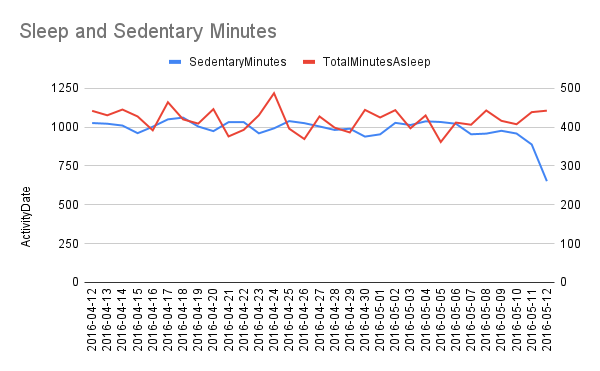
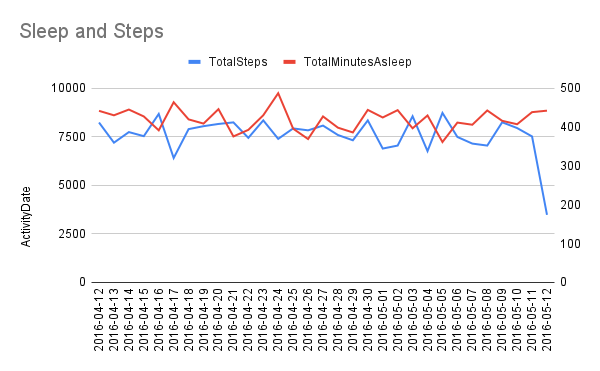
Other charts measuring more banal observations indicate that at least the commonly logged data is internally consistent. For example, the number steps taken each day correlates strongly with calories burned, as does the total distance traveled.
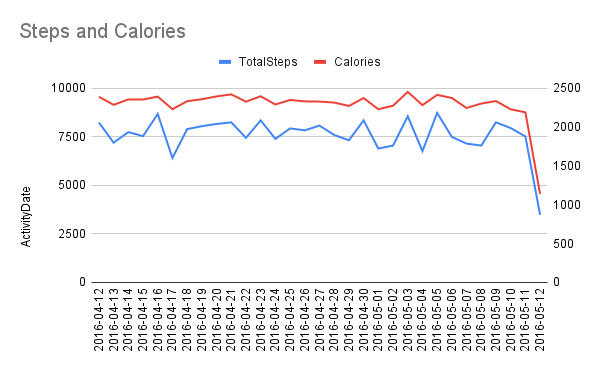
As I’d hoped, I was able to get more insight from bringing the data into RStudio. Although there isn’t a strong correlation between activity and sleep (-0.1815268), it does appear there is a moderate negative correlation between sleep and non-active minutes (-0.5869577). This suggests that sleep has a stronger effect on whether or not an individual will be active the next day:
> library(tidyverse)
> cor.test(dailyMerged1$TotalMinutesAsleep, dailyMerged1$ActiveMinutes, method="pearson")
Pearson's product-moment correlation
data: dailyMerged1$TotalMinutesAsleep and dailyMerged1$ActiveMinutes
t = -3.7286, df = 408, p-value = 0.0002197
alternative hypothesis: true correlation is not equal to 0
95 percent confidence interval:
-0.27356474 -0.08619484
sample estimates:
cor
-0.1815268
> cor.test(dailyMerged1$TotalMinutesAsleep, dailyMerged1$non_ActiveMinutes, method="pearson")
Pearson's product-moment correlation
data: dailyMerged1$TotalMinutesAsleep and dailyMerged1$non_ActiveMinutes
t = -14.644, df = 408, p-value < 2.2e-16
alternative hypothesis: true correlation is not equal to 0
95 percent confidence interval:
-0.6470247 -0.5196501
sample estimates:
cor
-0.5869577
>library(ggthemes)
>ggplot(dailyMerged1, aes(x = dailyMerged1$TotalMinutesAsleep, y = dailyMerged1$non_ActiveMinutes))+
geom_point() + geom_smooth(method=lm, se=FALSE, col="red") + labs(y = "Non-Active Minutes", x = "Total Minutes Asleep") + ggtitle("Relationship Between Sleep and Non-Activity")
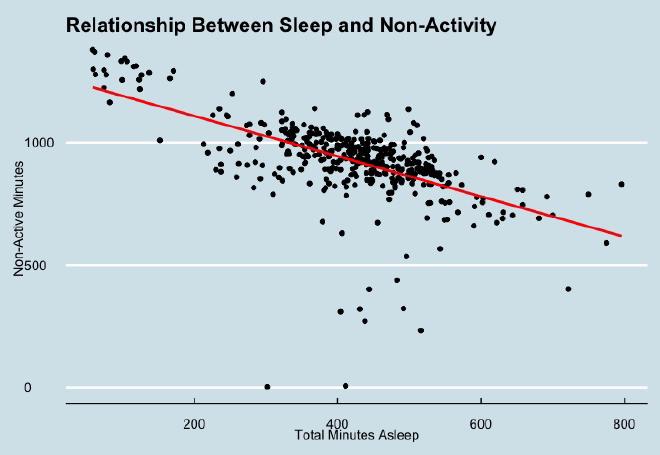
With all this daily data, it seemed prudent to aggregate the data by day of the week and see what trends I could find. With the following script, I was able to collate data based on day of the week (this codeblock is very long, so I put most of it behind an expandable section):
> # Monday
>
> day_Monday <- dailyMerged1 %>%
+ filter(dailyMerged1$DayOfWeek == "Monday") %>%
+ select(-c(Id, ActivityDate))
> summary(day_Monday)
Calories TotalSleepRecords TotalMinutesAsleep TotalTimeInBed TotalSteps TotalDistance
Min. :1248 Min. :1.000 Min. : 62.0 Min. : 65.0 Min. : 1831 Min. : 1.170
1st Qu.:1998 1st Qu.:1.000 1st Qu.:368.5 1st Qu.:399.8 1st Qu.: 6937 1st Qu.: 4.787
Median :2232 Median :1.000 Median :434.0 Median :467.5 Median : 9831 Median : 6.815
Mean :2432 Mean :1.109 Mean :419.5 Mean :457.3 Mean : 9273 Mean : 6.541
3rd Qu.:3007 3rd Qu.:1.000 3rd Qu.:492.8 3rd Qu.:528.8 3rd Qu.:11559 3rd Qu.: 8.265
Max. :4157 Max. :2.000 Max. :796.0 Max. :961.0 Max. :16520 Max. :11.050
TrackerDistance LoggedActivitiesDistance ActiveDistance non_ActiveDistance ActiveMinutes non_ActiveMinutes
Min. : 1.170 Min. :0.0000 Min. :0.000 Min. :1.120 Min. : 0.00 Min. : 322.0
1st Qu.: 4.787 1st Qu.:0.0000 1st Qu.:0.410 1st Qu.:3.045 1st Qu.: 10.25 1st Qu.: 882.5
Median : 6.815 Median :0.0000 Median :1.975 Median :3.930 Median : 44.50 Median : 931.5
Mean : 6.536 Mean :0.2826 Mean :2.519 Mean :4.016 Mean : 49.80 Mean : 940.8
3rd Qu.: 8.265 3rd Qu.:0.0000 3rd Qu.:3.980 3rd Qu.:4.855 3rd Qu.: 77.50 3rd Qu.:1000.0
Max. :11.050 Max. :3.0000 Max. :8.020 Max. :6.790 Max. :167.00 Max. :1278.0
DayOfWeek
Length:46
Class :character
Mode :character
>
> day_Mon_list <-
+ list(
+ list("Total_Steps_Ave" = ~ mean(day_Monday$TotalSteps, na.rm = TRUE)),
+ list("Active_Minutes_Ave" = ~ mean(day_Monday$ActiveMinutes, na.rm = TRUE)),
+ list("Sedentary_Minutes_Ave" = ~ mean(day_Monday$non_ActiveMinutes, na.rm = TRUE)),
+ list("Calories_Ave" = ~ mean(day_Monday$Calories, na.rm = TRUE)),
+ list("Total_Hours_Asleep_Ave" = ~ mean(day_Monday$TotalMinutesAsleep/60, na.rm = TRUE))
+ )
> day_Mon_summary <- summary_table(day_Monday, day_Mon_list)
> print.default(day_Mon_summary)
day_Monday (N = 46)
Total_Steps_Ave 9273.217391
Active_Minutes_Ave 49.804348
Sedentary_Minutes_Ave 940.782609
Calories_Ave 2431.978261
Total_Hours_Asleep_Ave 6.991667
attr(,"rgroups")
[1] 1 1 1 1 1
attr(,"n")
[1] 46
attr(,"class")
[1] "qwraps2_summary_table" "matrix" "array"
>
> # Tuesday
>
> day_Tuesday <- dailyMerged1 %>%
+ filter(dailyMerged1$DayOfWeek == "Tuesday") %>%
+ select(-c(Id, ActivityDate))
> summary(day_Tuesday)
Calories TotalSleepRecords TotalMinutesAsleep TotalTimeInBed TotalSteps TotalDistance TrackerDistance
Min. :1141 Min. :1.000 Min. :103.0 Min. :121.0 Min. : 254 Min. : 0.16 Min. : 0.16
1st Qu.:2026 1st Qu.:1.000 1st Qu.:342.0 1st Qu.:391.0 1st Qu.: 6582 1st Qu.: 4.95 1st Qu.: 4.95
Median :2291 Median :1.000 Median :417.0 Median :446.0 Median : 9648 Median : 6.76 Median : 6.76
Mean :2496 Mean :1.108 Mean :404.5 Mean :443.3 Mean : 9183 Mean : 6.43 Mean : 6.43
3rd Qu.:2944 3rd Qu.:1.000 3rd Qu.:465.0 3rd Qu.:498.0 3rd Qu.:11886 3rd Qu.: 8.39 3rd Qu.: 8.39
Max. :4092 Max. :3.000 Max. :750.0 Max. :775.0 Max. :16358 Max. :12.85 Max. :12.85
LoggedActivitiesDistance ActiveDistance non_ActiveDistance ActiveMinutes non_ActiveMinutes DayOfWeek
Min. :0.0000 Min. :0.000 Min. :0.160 Min. : 0.00 Min. : 754.0 Length:65
1st Qu.:0.0000 1st Qu.:0.000 1st Qu.:2.580 1st Qu.: 7.00 1st Qu.: 897.0 Class :character
Median :0.0000 Median :2.400 Median :3.950 Median : 43.00 Median : 956.0 Mode :character
Mean :0.1231 Mean :2.535 Mean :3.888 Mean : 50.66 Mean : 956.6
3rd Qu.:0.0000 3rd Qu.:4.510 3rd Qu.:5.030 3rd Qu.: 86.00 3rd Qu.:1014.0
Max. :2.0000 Max. :8.430 Max. :8.410 Max. :141.00 Max. :1345.0
>
> day_Tue_list <-
+ list(
+ list("Total_Steps_Ave" = ~ mean(day_Tuesday$TotalSteps, na.rm = TRUE)),
+ list("Active_Minutes_Ave" = ~ mean(day_Tuesday$ActiveMinutes, na.rm = TRUE)),
+ list("Sedentary_Minutes_Ave" = ~ mean(day_Tuesday$non_ActiveMinutes, na.rm = TRUE)),
+ list("Calories_Ave" = ~ mean(day_Tuesday$Calories, na.rm = TRUE)),
+ list("Total_Hours_Asleep_Ave" = ~ mean(day_Tuesday$TotalMinutesAsleep/60, na.rm = TRUE))
+ )
> day_Tue_summary <- summary_table(day_Tuesday, day_Tue_list)
> print.default(day_Tue_summary)
day_Tuesday (N = 65)
Total_Steps_Ave 9182.692308
Active_Minutes_Ave 50.661538
Sedentary_Minutes_Ave 956.630769
Calories_Ave 2496.200000
Total_Hours_Asleep_Ave 6.742308
attr(,"rgroups")
[1] 1 1 1 1 1
attr(,"n")
[1] 65
attr(,"class")
[1] "qwraps2_summary_table" "matrix" "array"
Expand
> # Wednesday
>
> day_Wednesday <- dailyMerged1 %>%
+ filter(dailyMerged1$DayOfWeek == "Wednesday") %>%
+ select(-c(Id, ActivityDate))
> summary(day_Wednesday)
Calories TotalSleepRecords TotalMinutesAsleep TotalTimeInBed TotalSteps TotalDistance TrackerDistance
Min. :1377 Min. :1.000 Min. :152.0 Min. :260 Min. : 356 Min. : 0.250 Min. : 0.250
1st Qu.:1789 1st Qu.:1.000 1st Qu.:392.0 1st Qu.:425 1st Qu.: 5318 1st Qu.: 3.748 1st Qu.: 3.748
Median :2207 Median :1.000 Median :444.5 Median :469 Median : 8686 Median : 6.175 Median : 6.175
Mean :2378 Mean :1.152 Mean :434.7 Mean :470 Mean : 8023 Mean : 5.720 Mean : 5.720
3rd Qu.:2942 3rd Qu.:1.000 3rd Qu.:477.0 3rd Qu.:525 3rd Qu.:10516 3rd Qu.: 7.418 3rd Qu.: 7.418
Max. :4079 Max. :3.000 Max. :658.0 Max. :679 Max. :15108 Max. :12.190 Max. :12.190
LoggedActivitiesDistance ActiveDistance non_ActiveDistance ActiveMinutes non_ActiveMinutes DayOfWeek
Min. :0.00000 Min. :0.000 Min. :0.250 Min. : 0.00 Min. : 320.0 Length:66
1st Qu.:0.00000 1st Qu.:0.000 1st Qu.:2.417 1st Qu.: 0.00 1st Qu.: 878.5 Class :character
Median :0.00000 Median :1.805 Median :3.590 Median : 33.50 Median : 924.5 Mode :character
Mean :0.09091 Mean :2.062 Mean :3.652 Mean : 38.08 Mean : 922.4
3rd Qu.:0.00000 3rd Qu.:2.910 3rd Qu.:5.062 3rd Qu.: 58.50 3rd Qu.: 977.8
Max. :2.00000 Max. :9.810 Max. :7.110 Max. :130.00 Max. :1138.0
>
> day_Wed_list <-
+ list(
+ list("Total_Steps_Ave" = ~ mean(day_Wednesday$TotalSteps, na.rm = TRUE)),
+ list("Active_Minutes_Ave" = ~ mean(day_Wednesday$ActiveMinutes, na.rm = TRUE)),
+ list("Sedentary_Minutes_Ave" = ~ mean(day_Wednesday$non_ActiveMinutes, na.rm = TRUE)),
+ list("Calories_Ave" = ~ mean(day_Wednesday$Calories, na.rm = TRUE)),
+ list("Total_Hours_Asleep_Ave" = ~ mean(day_Wednesday$TotalMinutesAsleep/60, na.rm = TRUE))
+ )
> day_Wed_summary <- summary_table(day_Wednesday, day_Wed_list)
> print.default(day_Mon_summary)
day_Monday (N = 46)
Total_Steps_Ave 9273.217391
Active_Minutes_Ave 49.804348
Sedentary_Minutes_Ave 940.782609
Calories_Ave 2431.978261
Total_Hours_Asleep_Ave 6.991667
attr(,"rgroups")
[1] 1 1 1 1 1
attr(,"n")
[1] 46
attr(,"class")
[1] "qwraps2_summary_table" "matrix" "array"
>
> # Thursday
>
> day_Thursday <- dailyMerged1 %>%
+ filter(dailyMerged1$DayOfWeek == "Thursday") %>%
+ select(-c(Id, ActivityDate))
> summary(day_Thursday)
Calories TotalSleepRecords TotalMinutesAsleep TotalTimeInBed TotalSteps TotalDistance
Min. : 257 Min. :1.000 Min. : 59.0 Min. : 65.0 Min. : 17 Min. : 0.010
1st Qu.:1788 1st Qu.:1.000 1st Qu.:377.2 1st Qu.:416.0 1st Qu.: 4363 1st Qu.: 2.925
Median :2168 Median :1.000 Median :423.5 Median :457.0 Median : 8752 Median : 6.355
Mean :2307 Mean :1.031 Mean :401.3 Mean :434.9 Mean : 8184 Mean : 5.773
3rd Qu.:2868 3rd Qu.:1.000 3rd Qu.:467.2 3rd Qu.:492.8 3rd Qu.:10971 3rd Qu.: 7.735
Max. :4900 Max. :2.000 Max. :545.0 Max. :568.0 Max. :19542 Max. :15.010
TrackerDistance LoggedActivitiesDistance ActiveDistance non_ActiveDistance ActiveMinutes non_ActiveMinutes
Min. : 0.010 Min. :0.0000 Min. :0.000 Min. :0.010 Min. : 0.00 Min. : 2.0
1st Qu.: 2.925 1st Qu.:0.0000 1st Qu.:0.000 1st Qu.:2.652 1st Qu.: 0.00 1st Qu.: 873.0
Median : 6.355 Median :0.0000 Median :1.360 Median :3.610 Median : 23.00 Median : 951.5
Mean : 5.745 Mean :0.1562 Mean :1.912 Mean :3.699 Mean : 38.72 Mean : 901.3
3rd Qu.: 7.735 3rd Qu.:0.0000 3rd Qu.:3.072 3rd Qu.:4.827 3rd Qu.: 66.25 3rd Qu.: 993.2
Max. :15.010 Max. :4.0000 Max. :7.720 Max. :7.700 Max. :184.00 Max. :1299.0
DayOfWeek
Length:64
Class :character
Mode :character
>
> day_Thur_list <-
+ list(
+ list("Total_Steps_Ave" = ~ mean(day_Thursday$TotalSteps, na.rm = TRUE)),
+ list("Active_Minutes_Ave" = ~ mean(day_Thursday$ActiveMinutes, na.rm = TRUE)),
+ list("Sedentary_Minutes_Ave" = ~ mean(day_Thursday$non_ActiveMinutes, na.rm = TRUE)),
+ list("Calories_Ave" = ~ mean(day_Thursday$Calories, na.rm = TRUE)),
+ list("Total_Hours_Asleep_Ave" = ~ mean(day_Thursday$TotalMinutesAsleep/60, na.rm = TRUE))
+ )
> day_Thur_summary <- summary_table(day_Thursday, day_Thur_list)
> print.default(day_Thur_summary)
day_Thursday (N = 64)
Total_Steps_Ave 8183.515625
Active_Minutes_Ave 38.718750
Sedentary_Minutes_Ave 901.312500
Calories_Ave 2306.671875
Total_Hours_Asleep_Ave 6.688281
attr(,"rgroups")
[1] 1 1 1 1 1
attr(,"n")
[1] 64
attr(,"class")
[1] "qwraps2_summary_table" "matrix" "array"
>
> # Friday
>
> day_Friday <- dailyMerged1 %>%
+ filter(dailyMerged1$DayOfWeek == "Friday") %>%
+ select(-c(Id, ActivityDate))
> summary(day_Friday)
Calories TotalSleepRecords TotalMinutesAsleep TotalTimeInBed TotalSteps TotalDistance
Min. : 403 Min. :1.00 Min. : 82.0 Min. : 85.0 Min. : 42 Min. : 0.030
1st Qu.:1850 1st Qu.:1.00 1st Qu.:355.0 1st Qu.:386.0 1st Qu.: 5563 1st Qu.: 3.680
Median :2196 Median :1.00 Median :405.0 Median :448.0 Median : 8198 Median : 5.630
Mean :2330 Mean :1.07 Mean :405.4 Mean :445.1 Mean : 7901 Mean : 5.512
3rd Qu.:2846 3rd Qu.:1.00 3rd Qu.:465.0 3rd Qu.:510.0 3rd Qu.:10465 3rd Qu.: 7.110
Max. :4044 Max. :2.00 Max. :658.0 Max. :961.0 Max. :16556 Max. :11.470
TrackerDistance LoggedActivitiesDistance ActiveDistance non_ActiveDistance ActiveMinutes non_ActiveMinutes
Min. : 0.030 Min. :0.00000 Min. :0.000 Min. :0.03 Min. : 0.00 Min. : 6.0
1st Qu.: 3.680 1st Qu.:0.00000 1st Qu.:0.000 1st Qu.:2.67 1st Qu.: 0.00 1st Qu.: 899.0
Median : 5.630 Median :0.00000 Median :0.880 Median :3.77 Median : 21.00 Median : 987.0
Mean : 5.512 Mean :0.07018 Mean :1.722 Mean :3.78 Mean : 35.74 Mean : 965.8
3rd Qu.: 7.110 3rd Qu.:0.00000 3rd Qu.:3.150 3rd Qu.:4.91 3rd Qu.: 61.00 3rd Qu.:1032.0
Max. :11.470 Max. :2.00000 Max. :6.140 Max. :7.24 Max. :169.00 Max. :1332.0
DayOfWeek
Length:57
Class :character
Mode :character
>
> day_Fri_list <-
+ list(
+ list("Total_Steps_Ave" = ~ mean(day_Friday$TotalSteps, na.rm = TRUE)),
+ list("Active_Minutes_Ave" = ~ mean(day_Friday$ActiveMinutes, na.rm = TRUE)),
+ list("Sedentary_Minutes_Ave" = ~ mean(day_Friday$non_ActiveMinutes, na.rm = TRUE)),
+ list("Calories_Ave" = ~ mean(day_Friday$Calories, na.rm = TRUE)),
+ list("Total_Hours_Asleep_Ave" = ~ mean(day_Friday$TotalMinutesAsleep/60, na.rm = TRUE))
+ )
> day_Fri_summary <- summary_table(day_Friday, day_Fri_list)
> print.default(day_Fri_summary)
day_Friday (N = 57)
Total_Steps_Ave 7901.403509
Active_Minutes_Ave 35.736842
Sedentary_Minutes_Ave 965.771930
Calories_Ave 2329.649123
Total_Hours_Asleep_Ave 6.757018
attr(,"rgroups")
[1] 1 1 1 1 1
attr(,"n")
[1] 57
attr(,"class")
[1] "qwraps2_summary_table" "matrix" "array"
>
> # Saturday
>
> day_Saturday <- dailyMerged1 %>%
+ filter(dailyMerged1$DayOfWeek == "Saturday") %>%
+ select(-c(Id, ActivityDate))
> summary(day_Saturday)
Calories TotalSleepRecords TotalMinutesAsleep TotalTimeInBed TotalSteps TotalDistance
Min. :1373 Min. :1.000 Min. : 61.0 Min. : 69.0 Min. : 1202 Min. : 0.780
1st Qu.:1863 1st Qu.:1.000 1st Qu.:340.0 1st Qu.:382.0 1st Qu.: 5079 1st Qu.: 3.420
Median :2363 Median :1.000 Median :426.0 Median :470.0 Median :10144 Median : 7.710
Mean :2507 Mean :1.193 Mean :419.1 Mean :459.8 Mean : 9871 Mean : 7.016
3rd Qu.:3073 3rd Qu.:1.000 3rd Qu.:507.0 3rd Qu.:539.0 3rd Qu.:13238 3rd Qu.: 9.240
Max. :4501 Max. :2.000 Max. :775.0 Max. :961.0 Max. :22770 Max. :17.540
TrackerDistance LoggedActivitiesDistance ActiveDistance non_ActiveDistance ActiveMinutes non_ActiveMinutes
Min. : 0.780 Min. :0 Min. : 0.000 Min. :0.590 Min. : 0.00 Min. : 402.0
1st Qu.: 3.420 1st Qu.:0 1st Qu.: 0.000 1st Qu.:2.730 1st Qu.: 0.00 1st Qu.: 850.0
Median : 7.710 Median :0 Median : 2.010 Median :3.770 Median : 44.00 Median : 911.0
Mean : 7.016 Mean :0 Mean : 2.747 Mean :4.266 Mean : 50.28 Mean : 927.2
3rd Qu.: 9.240 3rd Qu.:0 3rd Qu.: 4.160 3rd Qu.:5.330 3rd Qu.: 80.00 3rd Qu.: 998.0
Max. :17.540 Max. :0 Max. :13.320 Max. :9.480 Max. :252.00 Max. :1371.0
DayOfWeek
Length:57
Class :character
Mode :character
>
> day_Sat_list <-
+ list(
+ list("Total_Steps_Ave" = ~ mean(day_Saturday$TotalSteps, na.rm = TRUE)),
+ list("Active_Minutes_Ave" = ~ mean(day_Saturday$ActiveMinutes, na.rm = TRUE)),
+ list("Sedentary_Minutes_Ave" = ~ mean(day_Saturday$non_ActiveMinutes, na.rm = TRUE)),
+ list("Calories_Ave" = ~ mean(day_Saturday$Calories, na.rm = TRUE)),
+ list("Total_Hours_Asleep_Ave" = ~ mean(day_Saturday$TotalMinutesAsleep/60, na.rm = TRUE))
+ )
> day_Sat_summary <- summary_table(day_Saturday, day_Sat_list)
> print.default(day_Sat_summary)
day_Saturday (N = 57)
Total_Steps_Ave 9871.122807
Active_Minutes_Ave 50.280702
Sedentary_Minutes_Ave 927.210526
Calories_Ave 2506.894737
Total_Hours_Asleep_Ave 6.984503
attr(,"rgroups")
[1] 1 1 1 1 1
attr(,"n")
[1] 57
attr(,"class")
[1] "qwraps2_summary_table" "matrix" "array"
>
> # Sunday
>
> day_Sunday <- dailyMerged1 %>%
+ filter(dailyMerged1$DayOfWeek == "Sunday") %>%
+ select(-c(Id, ActivityDate))
> summary(day_Sunday)
Calories TotalSleepRecords TotalMinutesAsleep TotalTimeInBed TotalSteps TotalDistance
Min. :1214 Min. :1.000 Min. : 58.0 Min. : 61.0 Min. : 655 Min. : 0.430
1st Qu.:1698 1st Qu.:1.000 1st Qu.:380.0 1st Qu.:436.0 1st Qu.: 3688 1st Qu.: 2.600
Median :2027 Median :1.000 Median :481.0 Median :527.0 Median : 6543 Median : 4.330
Mean :2277 Mean :1.182 Mean :452.7 Mean :503.5 Mean : 7298 Mean : 5.185
3rd Qu.:2676 3rd Qu.:1.000 3rd Qu.:550.5 3rd Qu.:602.5 3rd Qu.:10334 3rd Qu.: 7.020
Max. :4552 Max. :3.000 Max. :700.0 Max. :961.0 Max. :17298 Max. :14.380
TrackerDistance LoggedActivitiesDistance ActiveDistance non_ActiveDistance ActiveMinutes non_ActiveMinutes
Min. : 0.430 Min. :0 Min. : 0.000 Min. :0.430 Min. : 0.00 Min. : 566.0
1st Qu.: 2.600 1st Qu.:0 1st Qu.: 0.000 1st Qu.:2.260 1st Qu.: 0.00 1st Qu.: 758.5
Median : 4.330 Median :0 Median : 0.000 Median :3.230 Median : 0.00 Median : 868.0
Mean : 5.185 Mean :0 Mean : 1.893 Mean :3.289 Mean : 38.91 Mean : 887.7
3rd Qu.: 7.020 3rd Qu.:0 3rd Qu.: 3.520 3rd Qu.:4.035 3rd Qu.: 58.50 3rd Qu.: 945.5
Max. :14.380 Max. :0 Max. :11.150 Max. :6.730 Max. :275.00 Max. :1379.0
DayOfWeek
Length:55
Class :character
Mode :character
>
> day_Sun_list <-
+ list(
+ list("Total_Steps_Ave" = ~ mean(day_Sunday$TotalSteps, na.rm = TRUE)),
+ list("Active_Minutes_Ave" = ~ mean(day_Sunday$ActiveMinutes, na.rm = TRUE)),
+ list("Sedentary_Minutes_Ave" = ~ mean(day_Sunday$non_ActiveMinutes, na.rm = TRUE)),
+ list("Calories_Ave" = ~ mean(day_Sunday$Calories, na.rm = TRUE)),
+ list("Total_Hours_Asleep_Ave" = ~ mean(day_Sunday$TotalMinutesAsleep/60, na.rm = TRUE))
+ )
> day_Sun_summary <- summary_table(day_Sunday, day_Sun_list)
> print.default(day_Sun_summary)
day_Sunday (N = 55)
Total_Steps_Ave 7297.854545
Active_Minutes_Ave 38.909091
Sedentary_Minutes_Ave 887.672727
Calories_Ave 2276.600000
Total_Hours_Asleep_Ave 7.545758
attr(,"rgroups")
[1] 1 1 1 1 1
attr(,"n")
[1] 55
attr(,"class")
[1] "qwraps2_summary_table" "matrix" "array"
> # Combine
>
> weekday_summary_rows <- cbind(day_Mon_summary, day_Tue_summary, day_Wed_summary, day_Thur_summary, day_Fri_summary, day_Sat_summary, day_Sun_summary, deparse.level = 1)
> weekday_summary = t(weekday_summary_rows) # flip (i.e., transpose) rows and columns to make data analysis easier
> rownames(weekday_summary) <- c("Monday", "Tuesday", "Wednesday", "Thursday", "Friday", "Saturday", "Sunday")
>
> sort(weekday_summary[, 1], decreasing = TRUE) # Total Steps Average
Saturday Monday Tuesday Thursday Wednesday Friday Sunday
9871.123 9273.217 9182.692 8183.516 8022.864 7901.404 7297.855
> sort(weekday_summary[, 2], decreasing = TRUE) # Active Minutes Average
Tuesday Saturday Monday Sunday Thursday Wednesday Friday
50.66154 50.28070 49.80435 38.90909 38.71875 38.07576 35.73684
> sort(weekday_summary[, 3], decreasing = TRUE) # Sedentary Minutes Average
Friday Tuesday Monday Saturday Wednesday Thursday Sunday
965.7719 956.6308 940.7826 927.2105 922.4242 901.3125 887.6727
> sort(weekday_summary[, 4], decreasing = TRUE) # Calories Average
Saturday Tuesday Monday Wednesday Friday Thursday Sunday
2506.895 2496.200 2431.978 2378.242 2329.649 2306.672 2276.600
> sort(weekday_summary[, 5], decreasing = TRUE) # Total Hours Asleep
Sunday Wednesday Monday Saturday Friday Tuesday Thursday
7.545758 7.244697 6.991667 6.984503 6.757018 6.742308 6.688281
Using ggplot, I made several charts describing my findings:
weekday_summary1 <- as.data.frame(weekday_summary)
library(ggthemes)
# Average Steps Chart
ggplot(data = weekday_summary1, aes(x = reorder(as.character(row.names(weekday_summary1)), -Total_Steps_Ave), y = Total_Steps_Ave)) +
geom_bar(stat="identity", fill = "#ff6262") +
labs(title="Average Steps by Day of Week", x = "Day of Week", y = "Average Total Steps") +
theme_economist()
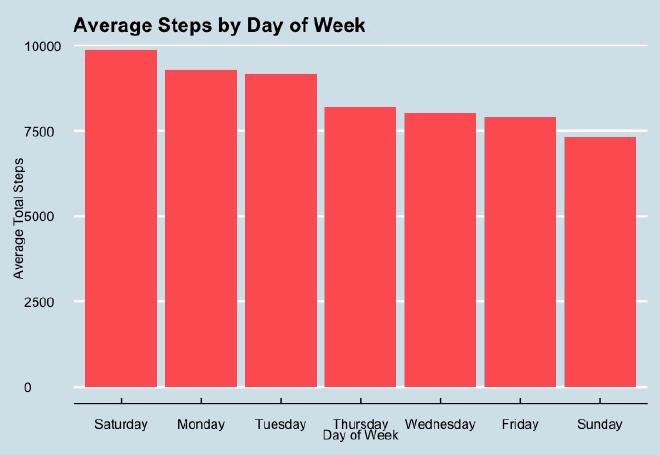
# Active Minutes Average Chart
ggplot(data = weekday_summary1, aes(x = reorder(as.character(row.names(weekday_summary1)), -Active_Minutes_Ave), y = Active_Minutes_Ave)) +
geom_bar(stat="identity", fill = "#ff6262") +
labs(title="Average Active Minutes by Day of Week", x = "Day of Week", y = "Average Active Minutes") +
theme_economist()
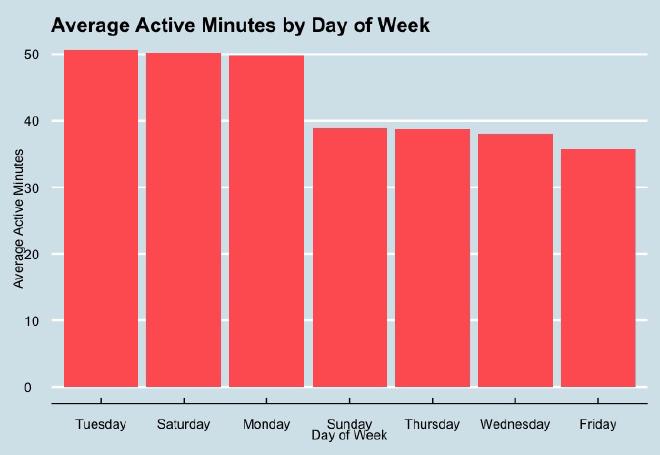
# Sedentary Minutes Average Chart
ggplot(data = weekday_summary1, aes(x = reorder(as.character(row.names(weekday_summary1)), -Sedentary_Minutes_Ave), y = Sedentary_Minutes_Ave)) +
geom_bar(stat="identity", fill = "#ff6262") +
labs(title="Average Sedentary Minutes by Day of Week", x = "Day of Week", y = "Average Sedentary Minutes") +
theme_economist()
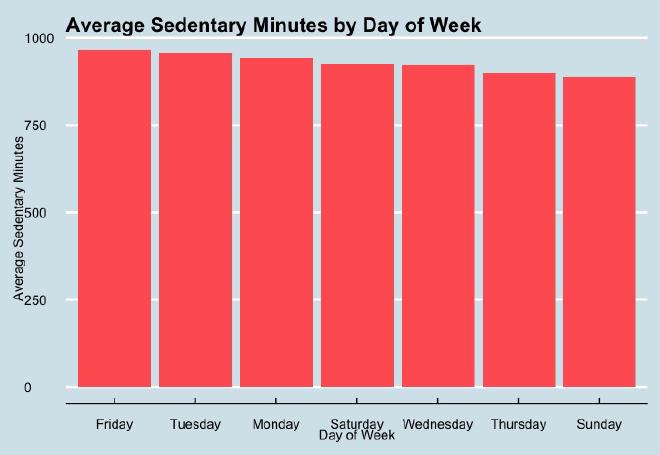
# Calories Average Chart
ggplot(data = weekday_summary1, aes(x = reorder(as.character(row.names(weekday_summary1)), -Calories_Ave), y = Calories_Ave)) +
geom_bar(stat="identity", fill = "#ff6262") +
labs(title="Average Calories by Day of Week", x = "Day of Week", y = "Average Calories") +
theme_economist()
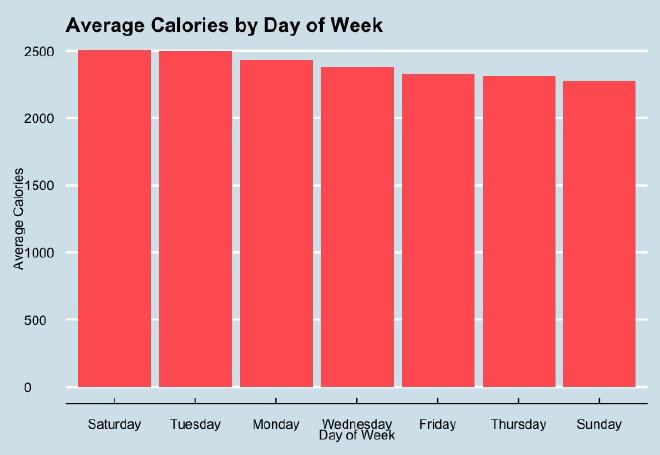
# Sleep Hours Average Chart
ggplot(data = weekday_summary1, aes(x = reorder(as.character(row.names(weekday_summary1)), -Total_Steps_Ave), y = Total_Steps_Ave)) +
geom_bar(stat="identity", fill = "#ff6262") +
labs(title="Average Hours of Sleep by Day of Week", x = "Day of Week", y = "Average Hours of Sleep") +
theme_economist()
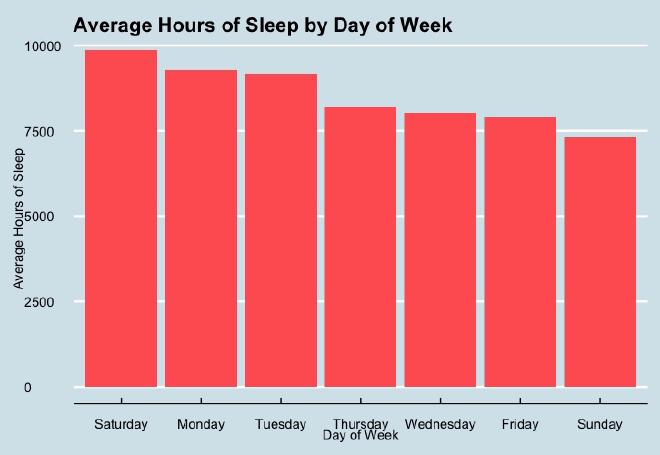
Interesting how both Tuesday and Monday are in the top three in each chart, even Average Sedentary Minutes. It seems that people are more likely to go easy on Fridays and stay up later. Overall, the differences between the days of the week aren’t as large as one might expect, but these differences are still notable enough to consider.
Hourly Data Analysis #
I imported hourlyMerged.csv into RStudio, where I could compare the relationship between calories, steps, and intensity. I first divided the activity hour column into activityDate and time, then converted them to the appropriate data types, then added times corresponding to the day of the week and the time of day:
library(lubridate)
hourlyMerged1$activityDate <- str_split_fixed(hourlyMerged1$activity_hour, " ", n = 2)[, 1]
hourlyMerged1$time <- str_split_fixed(hourlyMerged1$activity_hour, " ", n = 2)[, 2]
hourlyMerged1$activityDate <- as.Date(hourlyMerged1$activityDate, format="%Y-%m-%d")
hourlyMerged1$DayOfWeek <- format(as.Date(hourlyMerged1$activityDate), "%A")
breaks <- hour(hms("00:00:00", "05:59:59", "11:59:59", "17:59:59", "23:59:59"))
labels <- c("Night", "Morning", "Afternoon", "Evening")
hourlyMerged1$time <- as.POSIXct(hourlyMerged1$time, format = "%H:%M:%S")
hourlyMerged1$TimeOfDay <- cut(x = hour(hourlyMerged1$time), breaks = breaks, labels = labels, include.lowest=TRUE)
colSums(is.na(hourlyMerged1)) # No NA values.
There appeared to be no strong correlation between intensity and either steps or calories burned:
> cor.test(hourlyMerged1$average_intensity, hourlyMerged1$Calories, method = "pearson")
Pearson's product-moment correlation
data: hourlyMerged1$average_intensity and hourlyMerged1$Calories
t = 147.75, df = 15393211, p-value < 2.2e-16
alternative hypothesis: true correlation is not equal to 0
95 percent confidence interval:
0.03713366 0.03813135
sample estimates:
cor
0.03763252
> cor.test(hourlyMerged1$total_intensity, hourlyMerged1$Calories, method = "pearson")
Pearson's product-moment correlation
data: hourlyMerged1$total_intensity and hourlyMerged1$Calories
t = 147.75, df = 15393211, p-value < 2.2e-16
alternative hypothesis: true correlation is not equal to 0
95 percent confidence interval:
0.03713366 0.03813136
sample estimates:
cor
0.03763252
> cor.test(hourlyMerged1$total_intensity, hourlyMerged1$step_total, method = "pearson")
Pearson's product-moment correlation
data: hourlyMerged1$total_intensity and hourlyMerged1$step_total
t = 170.87, df = 15393211, p-value < 2.2e-16
alternative hypothesis: true correlation is not equal to 0
95 percent confidence interval:
0.04301144 0.04400866
sample estimates:
cor
0.04351006
> cor.test(hourlyMerged1$average_intensity, hourlyMerged1$step_total, method = "pearson")
Pearson's product-moment correlation
data: hourlyMerged1$average_intensity and hourlyMerged1$step_total
t = 170.87, df = 15393211, p-value < 2.2e-16
alternative hypothesis: true correlation is not equal to 0
95 percent confidence interval:
0.04301144 0.04400866
sample estimates:
cor
0.04351006
In this case, I thought it might be worth analyzing what time of day participants were most active: night, morning, afternoon, and evening.
> hourMorning <- hourlyMerged1 %>%
+ filter(hourlyMerged1$TimeOfDay == "Morning") %>%
+ select(c(step_total, total_intensity, Calories))
>
> summary(hourMorning)
step_total total_intensity Calories
Min. : 0.0 Min. : 0.00 Min. : 42.0
1st Qu.: 0.0 1st Qu.: 0.00 1st Qu.: 68.0
Median : 104.0 Median : 3.00 Median : 84.0
Mean : 374.8 Mean : 12.06 Mean :101.7
3rd Qu.: 467.0 3rd Qu.: 16.00 3rd Qu.:117.0
Max. :8976.0 Max. :180.00 Max. :544.0
>
>
> hourAfternoon <- hourlyMerged1 %>%
+ filter(hourlyMerged1$TimeOfDay == "Afternoon") %>%
+ select(c(step_total, total_intensity, Calories))
>
> summary(hourAfternoon)
step_total total_intensity Calories
Min. : 0.0 Min. : 0.00 Min. : 42.0
1st Qu.: 37.0 1st Qu.: 0.00 1st Qu.: 77.0
Median : 259.0 Median : 3.00 Median : 96.0
Mean : 519.6 Mean : 12.06 Mean :115.9
3rd Qu.: 620.0 3rd Qu.: 16.00 3rd Qu.:131.0
Max. :10554.0 Max. :180.00 Max. :948.0
>
> hourEvening <- hourlyMerged1 %>%
+ filter(hourlyMerged1$TimeOfDay == "Evening") %>%
+ select(c(step_total, total_intensity, Calories))
>
> summary(hourEvening)
step_total total_intensity Calories
Min. : 0.0 Min. : 0.00 Min. : 42.0
1st Qu.: 0.0 1st Qu.: 0.00 1st Qu.: 69.0
Median : 114.0 Median : 3.00 Median : 86.0
Mean : 370.9 Mean : 12.06 Mean :102.1
3rd Qu.: 398.0 3rd Qu.: 16.00 3rd Qu.:113.0
Max. :8586.0 Max. :180.00 Max. :834.0
>
> hourNight <- hourlyMerged1 %>%
+ filter(hourlyMerged1$TimeOfDay == "Night") %>%
+ select(c(step_total, total_intensity, Calories))
>
> summary(hourNight)
step_total total_intensity Calories
Min. : 0.00 Min. : 0.00 Min. : 42.00
1st Qu.: 0.00 1st Qu.: 0.00 1st Qu.: 56.00
Median : 0.00 Median : 3.00 Median : 68.00
Mean : 24.94 Mean : 12.06 Mean : 71.74
3rd Qu.: 0.00 3rd Qu.: 16.00 3rd Qu.: 83.00
Max. :2844.00 Max. :180.00 Max. :669.00
I then put all the summaries together to get a better idea of what time of day people were most active:
> hour_Morn_list <-
+ list(
+ list("Total_Steps_Ave" = ~ mean(hourMorning$step_total)),
+ list("Calories_Ave" = ~ mean(hourMorning$Calories))
+ )
> hour_Morn_summary <- summary_table(hourMorning, hour_Morn_list)
> print.default(hour_Morn_summary)
hourMorning (N = 3,886,786)
Total_Steps_Ave 374.7585
Calories_Ave 101.6646
attr(,"rgroups")
[1] 1 1
attr(,"n")
[1] 3886786
attr(,"class")
[1] "qwraps2_summary_table" "matrix" "array"
>
> hour_Aft_list <-
+ list(
+ list("Total_Steps_Ave" = ~ mean(hourAfternoon$step_total)),
+ list("Calories_Ave" = ~ mean(hourAfternoon$Calories))
+ )
> hour_Aft_summary <- summary_table(hourAfternoon, hour_Aft_list)
> print.default(hour_Aft_summary)
hourAfternoon (N = 3,825,364)
Total_Steps_Ave 519.5996
Calories_Ave 115.8662
attr(,"rgroups")
[1] 1 1
attr(,"n")
[1] 3825364
attr(,"class")
[1] "qwraps2_summary_table" "matrix" "array"
>
> hour_Eve_list <-
+ list(
+ list("Total_Steps_Ave" = ~ mean(hourEvening$step_total)),
+ list("Calories_Ave" = ~ mean(hourEvening$Calories))
+ )
> hour_Eve_summary <- summary_table(hourEvening, hour_Eve_list)
> print.default(hour_Eve_summary)
hourEvening (N = 3,784,154)
Total_Steps_Ave 370.9224
Calories_Ave 102.1464
attr(,"rgroups")
[1] 1 1
attr(,"n")
[1] 3784154
attr(,"class")
[1] "qwraps2_summary_table" "matrix" "array"
>
> hour_Night_list <-
+ list(
+ list("Total_Steps_Ave" = ~ mean(hourNight$step_total)),
+ list("Calories_Ave" = ~ mean(hourNight$Calories))
+ )
> hour_Night_summary <- summary_table(hourNight, hour_Night_list)
> print.default(hour_Night_summary)
hourNight (N = 3,896,909)
Total_Steps_Ave 24.93547
Calories_Ave 71.73854
attr(,"rgroups")
[1] 1 1
attr(,"n")
[1] 3896909
attr(,"class")
[1] "qwraps2_summary_table" "matrix" "array"
> timeofday_summary_rows <- cbind(hour_Morn_summary, hour_Aft_summary, hour_Eve_summary, hour_Night_summary)
> timeofday_summary = t(timeofday_summary_rows)
>
> sort(timeofday_summary[, 1], decreasing = TRUE)
hourAfternoon (N = 3,825,364) hourMorning (N = 3,886,786) hourEvening (N = 3,784,154)
519.59962 374.75847 370.92242
hourNight (N = 3,896,909)
24.93547
> sort(timeofday_summary[, 2], decreasing = TRUE)
hourAfternoon (N = 3,825,364) hourEvening (N = 3,784,154) hourMorning (N = 3,886,786)
115.86621 102.14637 101.66459
hourNight (N = 3,896,909)
71.73854
Finally, let’s once again put those data into charts:
# Average Steps by Time of Day
ggplot(data = timeofday_summary1, aes(x = reorder(as.character(row.names(timeofday_summary1)), -Total_Steps_Ave), y = Total_Steps_Ave)) +
geom_bar(stat="identity", fill = "#ff6262") +
labs(title="Average Steps by Time of Day", x = "", y = "Average Total Steps") +
theme_economist()
# Average Calories by Time of Day
ggplot(data = timeofday_summary1, aes(x = reorder(as.character(row.names(timeofday_summary1)), -Calories_Ave), y = Calories_Ave)) +
geom_bar(stat="identity", fill = "#ff6262") +
labs(title="Average Calories by Time of Day", x = "", y = "Average Calories") +
theme_economist()
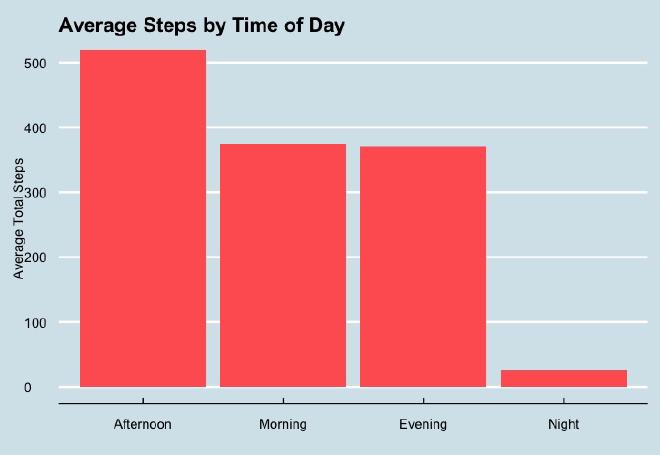
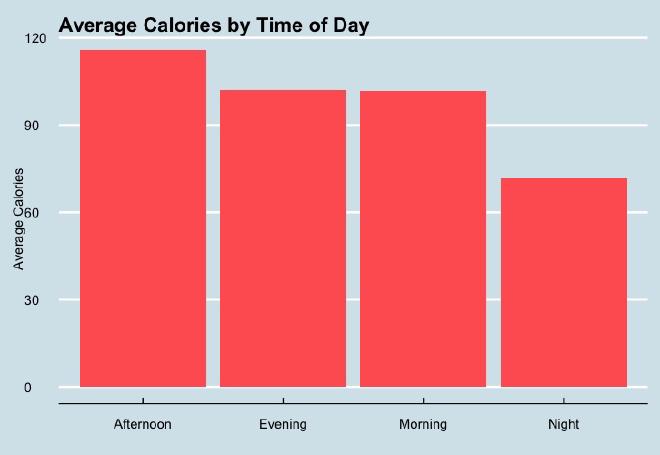
No surprise that nighttime ranks last for physical activity. People are slightly yet significantly more likely to be more active during the afternoon than the evening or morning.
Summary #
1. What are some trends in smart device usage? The clearest trend is that FitBit simply isn’t collecting enough data.
2. How could these trends apply to Bellabeat customers? If the customers can’t log this data easily, then they’re missing out on a lot of very useful insights.
3. How could these trends help influence Bellabeat marketing strategy? These gaps in FitBit’s data are a great opportunity for BellaBeat to step in and provide something their competitors have thus far been unable to provide.
Recommendations #
- Incentivize customers to engage with the app and device on “off days”.
- For example, if Friday is a day when customers are consistently less active and more sedentary, the app should encourage them to engage in some light physical activity.
- Investigate friction in the weight-logging feature.
- Body weight is important data for anyone trying to improve their health. Whatever is preventing customers from regularly logging their weight needs to be uncovered and corrected.
- Weight needs to be measured at regular intervals and under the same conditions for the data to be helpful. An individual’s weight can fluctuate dramatically throughout the day, so a person can appear to be up to ten pounds (4.5kg) heavier or lighter depending on when they logged their weight. This is one of the rare cases when too many readings can spoil the utility of the dataset. Perhaps the customer can be encouraged to set a weekly timer to remind them to weigh themselves under similar conditions. If they want to weigh themselves outside of these time frames, they should receive a dialog box confirming that they understand the issues with doing so.
- Perhaps there can be hardware integration with smart scales, much in the same way as BellaBeat’s Spring water bottle automatically tracks hydration.
- Encourage users to wear the device to bed.
- Sleep is just as important to a healthy life as exercise and a balanced diet. BellaBeat should strongly encourage their customers go to bed at an appropriate time for each of their schedules while wearing one of the company’s products. BellaBeat can really stand out in their field if they can use abundant and accurate sleep data to help their customers.
- It’s also possible that the particular device used to track sleep wasn’t conducive to tracking sleep. For example, maybe some customers find wearing a wristwatch to bed to be too uncomfortable to be worth it. In such a case, this might require a hardware solution.
- Improve data integration
- Even when the data has been gathered amply and correctly, they seem to be disconnected from each other. Sure, steps taken correlate strongly with calories burned, but that’s a banal observation. It’s very hard to see how someone can look at this FitBit data at a glance and use it to change their habits and routines. BellaBeat should not only be gathering better data than FitBit, but it should also leverage that data better to provide interesting and actionable insights to their customers.
- The customer should feel like their data is being gathered and deployed to improve their lives. This can incentivize them to more regularly log their data and wear the tracking devices while sleeping. Without this sense of purpose, the customer will stop engaging with the device seriously.
Acknowledgments #
I’d like to thank Ed Garcia for his guidance on how to divide the data into days of the week and times of the day.